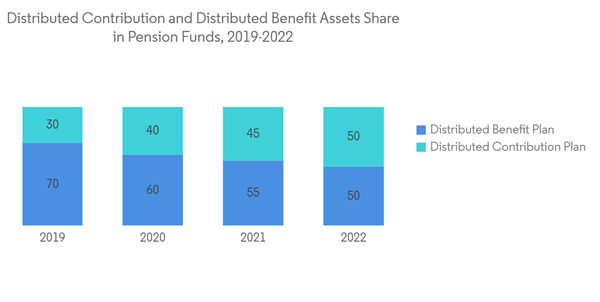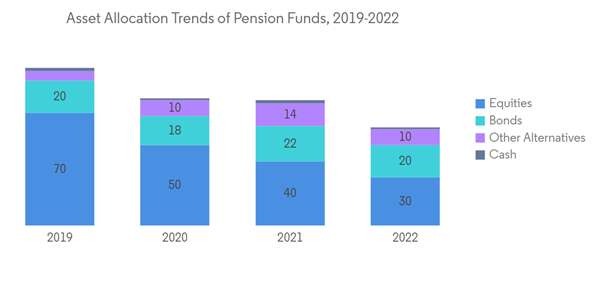The Global Pension Funds Industry in terms of assets under management value is expected to grow from USD 76.30 trillion in 2024 to USD 119.03 trillion by 2029, at a CAGR of 5.40% during the forecast period (2024-2029).
Pension fund schemes invest with a long-term investment perspective in line with the duration of their liabilities. Pension funds are adapting their investment strategies to succeed in the current complex and demanding environment.
The COVID-19 pandemic had a significant impact on investment markets, government revenues, and the outlook for public pension plans. Despite vaccine development, the effect of the pandemic remained highly uncertain, resulting in varying forecasts. At different times, different parts of the country experienced varying degrees of pandemic severity, and the economic impact of the pandemic on industries varied greatly.
Traditionally, pension funds are invested in bonds and equities with long-term investment horizons. Given the market volatility, they diversified their portfolios by allocating funds to alternatives like hedge funds, private equity, real estate, and others. Recent years have witnessed intense pension reform efforts in countries around the world, often involving increased use of funded pension programs managed by the private sector. These funded arrangements are expected to play an increasingly important role in delivering retirement income in many countries. Privately managed pension assets may play an increasing role in financial markets, notably as a source of long-term savings.
Along with a rise in the distributed contribution assets, there are challenges like member engagement for employers. Targeted engagement provides better insights but faces challenges in execution. Advances in technology are opening up new possibilities for customization, changing the nature of member interactions, and re-setting member expectations. The future of DC is anticipated to be hyper-customized, with an increased focus on individual participants, but employers may need to improve governance to embrace this.
A rise in allocations to private markets and other alternatives at the expense of equities and bonds has been observed, reflecting the demand for risk diversification. Investors continue looking for innovative ways to evolve their mandates to manage the agency, measurement, integration, and complexity challenges of private markets.
This product will be delivered within 2 business days.
Pension fund schemes invest with a long-term investment perspective in line with the duration of their liabilities. Pension funds are adapting their investment strategies to succeed in the current complex and demanding environment.
The COVID-19 pandemic had a significant impact on investment markets, government revenues, and the outlook for public pension plans. Despite vaccine development, the effect of the pandemic remained highly uncertain, resulting in varying forecasts. At different times, different parts of the country experienced varying degrees of pandemic severity, and the economic impact of the pandemic on industries varied greatly.
Traditionally, pension funds are invested in bonds and equities with long-term investment horizons. Given the market volatility, they diversified their portfolios by allocating funds to alternatives like hedge funds, private equity, real estate, and others. Recent years have witnessed intense pension reform efforts in countries around the world, often involving increased use of funded pension programs managed by the private sector. These funded arrangements are expected to play an increasingly important role in delivering retirement income in many countries. Privately managed pension assets may play an increasing role in financial markets, notably as a source of long-term savings.
Pension Fund Market Trends
Distributed Contribution Plans are Settling as a Dominant Global Model
In 2021, the total defined contribution (DC) assets across the aggregate of the six largest pension markets in the world exceeded defined benefit (DB) assets for the first time. Over the decade to 2021, DC assets continued to grow at a faster rate than DB (8.4% pa vs. 4.8% pa), reflecting increased member coverage and higher contributions in some markets.Along with a rise in the distributed contribution assets, there are challenges like member engagement for employers. Targeted engagement provides better insights but faces challenges in execution. Advances in technology are opening up new possibilities for customization, changing the nature of member interactions, and re-setting member expectations. The future of DC is anticipated to be hyper-customized, with an increased focus on individual participants, but employers may need to improve governance to embrace this.
Key Trends in Asset Allocation of Pension Funds
The asset allocation to real estate, private equity, and infrastructure in the 20-year period grew from 6% to 23%. Alternatives have been attractive for return reasons, offsetting their governance difficulties.A rise in allocations to private markets and other alternatives at the expense of equities and bonds has been observed, reflecting the demand for risk diversification. Investors continue looking for innovative ways to evolve their mandates to manage the agency, measurement, integration, and complexity challenges of private markets.
Pension Fund Industry Overview
The report includes an overview of the largest pension funds and a few corporate funds operating pension schemes worldwide. Some of the major players, such as Social Security Trust Funds, AT&T Corporate Pension Fund, and California Public Employees' Retirement System, are dominating the market studied in terms of asset size and are discussed in detail in the report.Additional Benefits:
- The market estimate (ME) sheet in Excel format
- 3 months of analyst support
This product will be delivered within 2 business days.
Table of Contents
1 INTRODUCTION
4 MARKET DYNAMICS
5 MARKET SEGMENTATION
6 COMPETITIVE LANDSCAPE
Methodology

LOADING...










